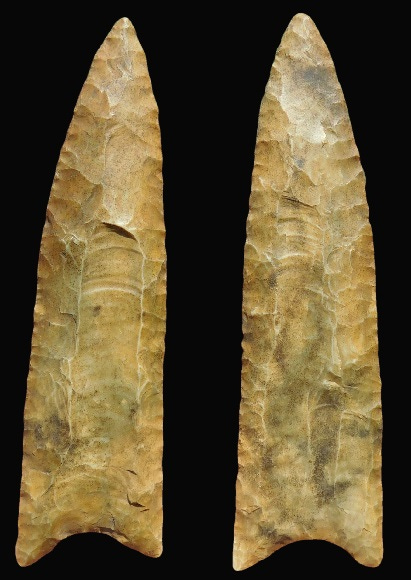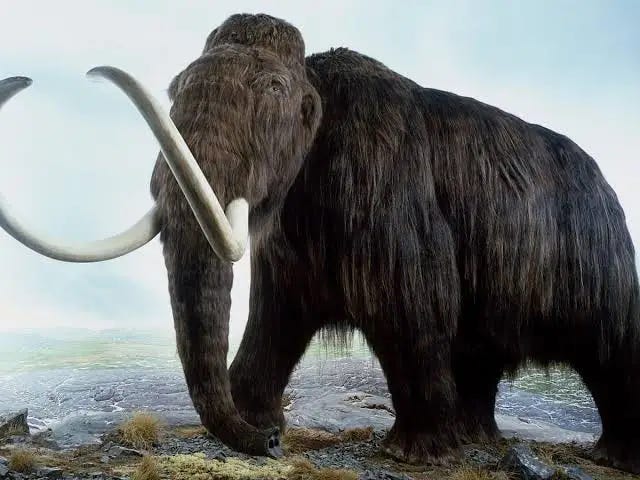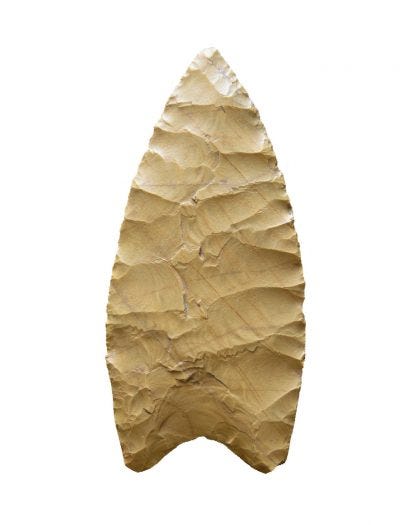Little is known about the everyday life of the Clovis People. A consensus exists among the sciences that they migrated along an ice-free corridor between Beringia and Yukon (modern day Russia and Alaska) south into the Americas 10-13,000 years ago. Others suggest a migration from the southern Americas if we are considering a “first people” to enter the continent. Either way it is accepted that Clovis were not the earliest inhabitants, but a distinct culture who appeared for a relatively brief period and spread rapidly throughout the northern land mass.
We can consider they moved in organized family groups traveling long distances hunting and gathering living in simple huts and rock shelters. Their diets would have been varied including drupes, nuts, small game, aquatic resources and large game.
All of this is a loose interpretation of the actual scientific research; one thing is certain - a sizeable group of people expending lots of calories would require an equally sizeable amount of food. According to the last living mountain man the key to survival in the wilds would involve killing the largest animal possible.
This would be what their supermarket looked like:
There are lots of ways to approach such a problem, it only makes sense to evolve methods that might be less fatal to the predator. Maybe they hunted in packs or favored weaker specimens or even carrion. Maybe they corralled them or drove them off cliffs. Likely they would have preferred the larger, stronger individuals for the freshest meat and greatest harvest. No one knows for certain.
We do know it was technological prowess that enabled the Clovis to rapidly expand their influence and sweep across a vast territory likely spreading cultural and artistic traits until their disappearance, along with the megafauna.
There is only a single purpose for the sharply pointed tool, that is to pierce. People have been piercing things for a long time and there are lots of materials to get the job done. Stone is durable, can be shaped, lasts a long time and is plentiful. It would not be a stretch to imagine piercing tools evolving over a very long period of time, each generation improving on the last with better raw material and skill in execution to better meet the demands of its purpose. The Clovis people took this to a high art.
Much research has gone into reconstructing the Clovis technology, much of it unrealistic, some of it quite feasible and some trialed in real world conditions hunting large game. Flight characteristics, physical construction, materials are still debated and misunderstood. No intact wooden artifacts survived the thousands of years of entropy, no shafts, bows or atlatl have been discovered - we will never know for certain.
The Clovis point survived the ravages of time because it is stone. Much can be surmised from its design. A couple things are easily overlooked: the objective is penetration and maximum hemorrhaging of the targeted animal. These were subsistence hunters, stalkers who waited their opportunity, struck a well-placed blow and likely drove the terrified animal while continuing the attack and hastening its blood loss. You would want to bring the animal down as quickly as possible to ensure it doesn’t escape or travel far before dying.
The Clovis point is a wedge in multiple aspects:
It’s a wedge in three aspects: longitudinally, in cross section as a lenticular (lens shape) and at its base (the fluted end). We will propose that the Clovis people worked with green wood and the point is a multi-tool which is light, carries well and if it’s all you had could do everything else needed. In forested areas in particular he could select a shaft from a variety of woody species then cut, scrape and split all with a single tool. Insert the point into the split, lash it with whatever you have and hunt down dinner. Shafts are consumables, quickly made and often broken. The point is recoverable and then used for butchering, fleshing and shaft making among lots of other tasks. Keep spares, make more points, seek that special stone that just seems to work well. Spend time on larger tools for the larger tribal hunts when called upon, the good stuff. And finally, the ceremonial pieces of the finest rare stone and petrified substance from distant places obtained by trade and vision quest.
Here’s the thing
The fluted base of the Clovis point is a sharpened concave wedge; it appears to be a splitting tool as much as a secure attachment method. We could harvest a suitable stick and start a split by tapping the edge of the point into the end grain, then present the base to the partial split and seat it by tapping the opposite end of the stick or inverting the point and easily push the stick home. The split ends of the stick are then scraped down to make a smooth transition along the point for best penetration. These scraped ends are sharp, if the lashing is light enough and the impact great enough, the edges of the point will cut through the lashing, and the fluted base will split the shaft spreading the sharp pointed ends of the stick. Whether by accident or intention this surely must have happened. The result might be embedding the shaft in the animal, enlarging the wound, or increasing blood loss, all good outcomes when attempting to procure food efficiently.
Standing around their fires we would certainly seem the fools trying to re-engineer magic. The simple magic all around us; the culmination of countless souls over timeless spans trial and erring without end.






The beginning of Native Americans